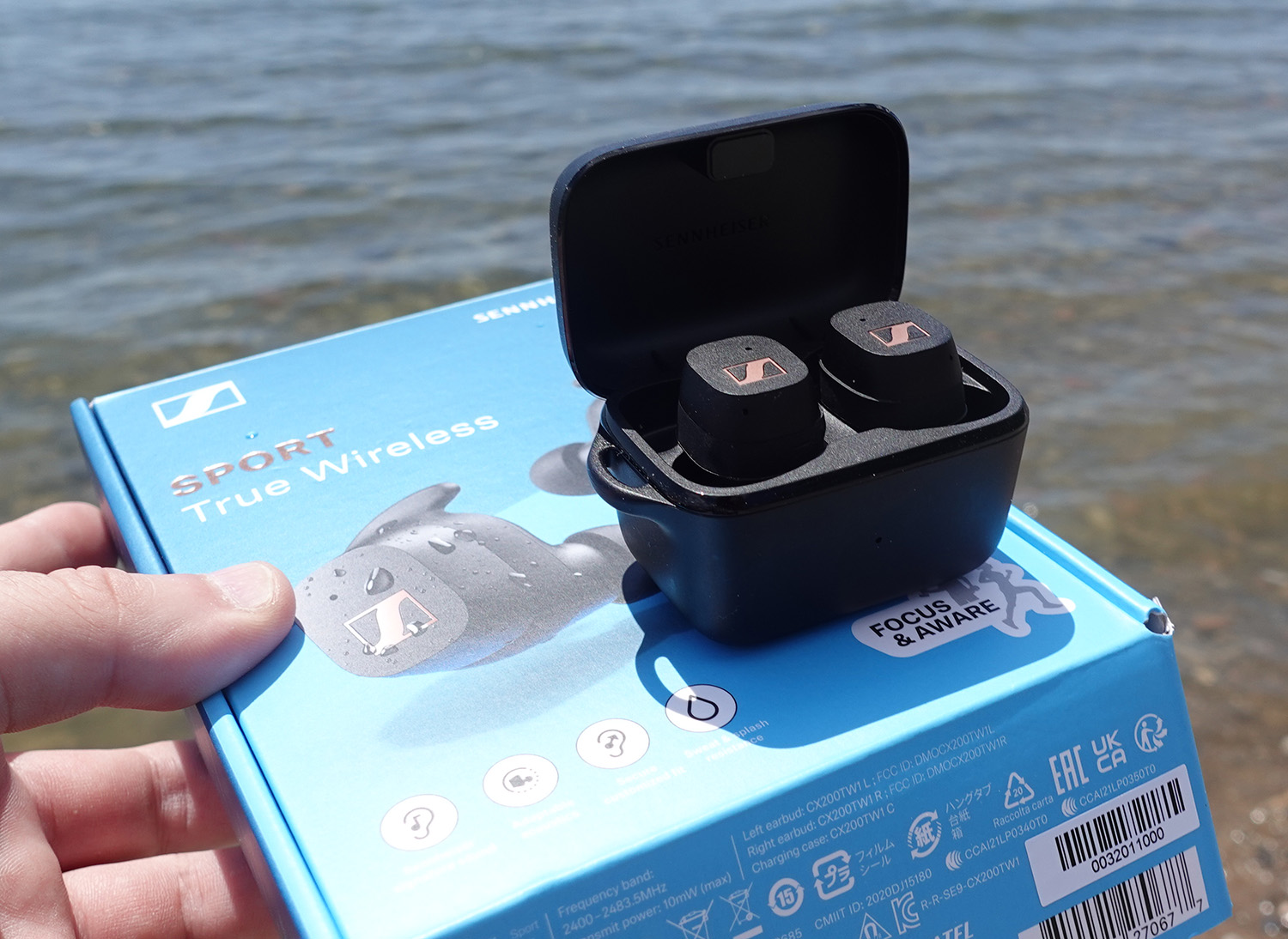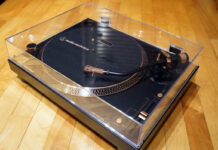 For decades the Sennheiser name has been branded on equipment that shapes the forefront of audio technology. Their products have catered to an audience interested in a balanced, neutral sound, positioning accuracy of musical reproduction over sweetening the sound to fool the ear.
For decades the Sennheiser name has been branded on equipment that shapes the forefront of audio technology. Their products have catered to an audience interested in a balanced, neutral sound, positioning accuracy of musical reproduction over sweetening the sound to fool the ear.
As the owner of several Sennheiser over-the-ear products, from entry level right through their highest end models, I was intrigued to see how Sennheiser SPORT true wireless earbuds would translate into the earbud market, particularly with a model ostensibly designed not for critical listening sessions but more for use while on a run or in the gym. Does the SPORT in-ear model live up to Sennheiser’s reputation? Let’s find out!
Specifications of Sennheiser SPORT wireless earbuds
-
- Adaptable acoustics via replaceable ear tips
- S/M/L ear tips for both open/closed
- IP54 dust/splash/sweat resistance
- 27hrs playtime (9hrs continuous, charged via case)
- S/M/L replaceable rubber earfins for solid/secure fit
- Bluetooth 5.2 (SBC/AAC/aptX)
- 7mm drivers
- Weight: 0.24oz x 2 (1.47oz for case)
 What’s included with the Sennheiser SPORT earbuds
What’s included with the Sennheiser SPORT earbuds
The case is a small yet well-constructed box, shaped somewhat like those little treasure chests you see in old-school fishtanks. There’s a lanyard slot for those that want to carry the charger about, and a little flap hides the USB-C charging slot. Lifting up the top panel reveals two chunky, square-faced earphones that have ear tips that protrude from the bottom.
You get an instruction manual, a USB-A to C charging cable, and a set of replaceable eartips and fins to create a secure fit no matter the shape of those things on either side of your head.
Testing the sound and comfort of the Sennheiser SPORT earbuds
There are plenty of customization settings for these earphones using Sennheiser’s Smart Control app, including a full custom EQ setup and even an audio test to personalize your listening preferences. I admit to being a bit pleased that my preferred sound was neutral EQ, though of course others may wish to juice up the bass or treble to their heart’s content.
As these are meant to lock into your ears, the included rubber fins do a nice job of making the squared-off profile stick in place. I appreciated the various size options, including a “blank” one that removed the fin all together, making it more comfortable than any other option while still keeping the buds in place no matter my head’s orientation.
Listening to Paul Simon’s “You Can Call My Al” off Tidal Master and Spotify HD showed the well-rounded, clear sound of the drivers, with enough bass and shiny but not brittle treble along with warm and rich mids. Switching between different Bluetooth codecs showed an obvious increase in audio fidelity. While AptX suffers from latency when watching video, the increase in sound quality is notable. In short, it’s clear the audio drivers are very well designed, and this model greatly benefits from shared technology with some of Sennheiser’s higher-end models.
While they won’t replace my higher-end in-ear monitors, the SPORT model has been great at listening without fear of getting water or sand in them. For things like podcasts they’re of course fantastic, but even in critical listening situations they more than hold their own against models costing many times their retail price. Even phone calls were clear, and on city streets people were able to understand my conversation without complaint.
Adaptable acoustics on the Sennheiser SPORT wireless earbuds
These earbuds use what the boffins at Sennheiser refer to as “adaptable acoustics”. By simply switching between the included rubber earpads you can switch between aware and focus modes. Aware mode lets in a bit more outside sound, and while nowhere near the capability of a true immersive mode that uses built-in microphones to allow a mix of outside sound into the drivers, it still manages to replicate in part an “open-back” sound that’s the remit of many high-end over-the-ear models. On the workout front it’s meant to allow you to hear your environment better during a run while reducing the sound of your heartbeat or breathing, avoiding that loop-back of your own body’s sounds you get from a fully-sealed solution.
In turn, the focus mode essentially seals you off from most outside sounds, dramatically attenuating external distractions. Using the app (available for free for both Android and iOS) you can easily switch between modes as you switch earpads. It’s fair to say that the focus is a far more accurate soundstage, and when using those pads you can truly hear just how much EQ boosting is done to replicate a similar sound signature when using the aware mode, blue-ringed bits of rubber padding. On first listening there may not be much difference to casual listeners, but I certainly found the focus mode to provide a far better and more accurate representation of the sound, and simply took for granted that I was in my own sonic bubble. I very much enjoy that I have the choice, and it could not be easier to switch back and forth while still having musically pleasing sound with either option. Note that even on aware mode there’s no sound bleeding out to your neighbours, making either earpad transit friendly.
Do you need to be active to enjoy the Sennheiser SPORT earbuds?
Under normal circumstances I would tell you tall tales of lifting weights or running marathons with the SPORT earphones, testing their moisture-resistant construction while dripping with sweat and blaring an obnoxious, high-intensity workout mix. I, being both an audiophile as well as excessively lazy, did much of my testing instead enjoying the summer weather laying in a hammock, walking the streets of my city, and even flying a kite at the beach. My playlist consisted of jazz, folk, rock, and funk, all to test the timbre and musicality of the device for those who may not be strictly picking these up for more aerobic uses.
What you may be missing from the Sennheiser SPORT earbuds
While a simple USB-C port does the trick when plugging in the case, there’s no ability to wirelessly charge. There’s also no active noise cancellation, which for some may be a deal breaker. As someone who is not a fan of ANC in most circumstances, and prefers instead a sealed earbud for a “passible”, earplug-like external sound suppression, this is actually a benefit in my books as it reduces the price and simply focuses on the best sound possible.
Additionally, while there is integration to voice assistants like Siri and Google Assistant I found the results a bit flaky, though this may improve with software updates.
Final thoughts on the Sennheiser SPORT true wireless earbuds
Though there is plenty of competition in this range of earbud models from a wide variety of manufactures, I am quite sure that the Sennheiser SPORT earbuds manage to trump even those with a higher price. The ability to easily tune the sound, either through replacement earpads or via custom EQ, makes them far more enjoyable to listen to music than competing efforts, outside of their use in more kinesthetic environments. By employing trickle-down technology from some of Sennheiser’s own sister models, we’re treated to a well sounding, robust pair of earbuds that are perfect for use either while engaged in the sporting activities that give the model its name, or simply laying about knowing that you’re protected from all but the most cataclysmic of environmental disruption.
The Sennheiser SPORT true wireless earbuds sound great, they’re comfortable to use even for hours upon hours of listening, and they manage to do all this within an attractive package that prioritizes function over fancy form. It’s another elegant solution from Sennheiser, and you should definitely consider a pair not only if you’re planning on some grand exercise adventure, but even if, like me, you just want something that works well while engaged in Olympian levels of laziness.
Shop the Sennheiser SPORT true wireless earbuds and check out more top quality Sennheiser audio products at bestbuy.ca today!



